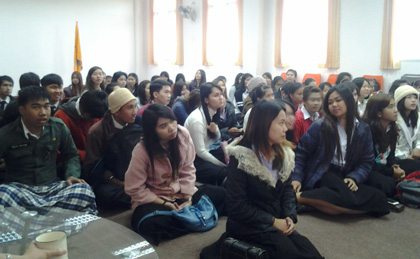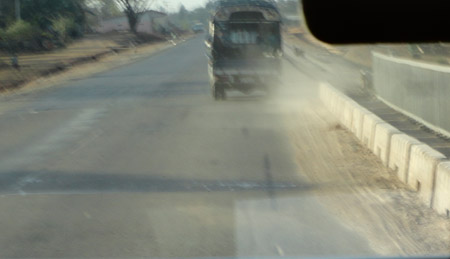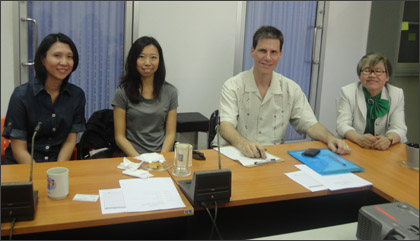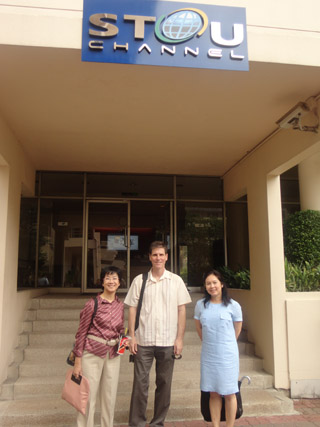Teaching on the Mukdahan Campus
After settling into a rental house, I started work at the Mukdahan campus. Orientation was on January 9th, I was introduced to the students briefly during a general assembly. I spoke to the students and was encouraged by their comprehension of English, although they tend to be less willing to actually talk in English. We (the faculty and I) have been working to develop a strategy for teaching a class in entrepreneurship (with a focus on IT). From the faculty perspective their interest is to take advantage of the value I can bring to their ICT major, the help I can provide developing a research agenda and the research project using open content at the university. As a Fulbright scholar it is important to mention that harboring expectations about how research will proceed may not be the most advantageous approach. The simple fact is that circumstances change and that naturally has some effect on the specifics of a research agenda (and teaching strategies). In the case of Mukdahan, it may be that the influence of ASEAN 2015 combined with Mukdahan recently being nominated as the first (and only) special economic zone in the Northeast that the path ahead isn't quite clear to anybody. Regardless, the best advice I received before leaving the US was to "keep an open mind," to which I would add be flexible and pay attention to what can be learned "on the ground."
 It was a pleasure to meet the IT students, I am sure that neither party knew quite what to expect when we met for the first time and as I discovered during the first class, things became even more interesting. The first Monday of the semester is a holiday and so my class didn't start until January 19 so I used that extra time to (over) prepare. It was clear from the general assembly that the students are not proficient enough to absorb a lecture in English, and (of course) many of the activities that I normally use are printed in English. Needless to say, the class prep took three times longer because I wasn't sure what would work and so my lesson plan included a variety of activities and the teaching notes I gathered from my research had to be converted into information graphics that minimized reading.
It was a pleasure to meet the IT students, I am sure that neither party knew quite what to expect when we met for the first time and as I discovered during the first class, things became even more interesting. The first Monday of the semester is a holiday and so my class didn't start until January 19 so I used that extra time to (over) prepare. It was clear from the general assembly that the students are not proficient enough to absorb a lecture in English, and (of course) many of the activities that I normally use are printed in English. Needless to say, the class prep took three times longer because I wasn't sure what would work and so my lesson plan included a variety of activities and the teaching notes I gathered from my research had to be converted into information graphics that minimized reading.
During the class, Tony (another professor) acted as a co-teacher. Thank goodness Tony was there to translate and reinforce important points. We changed the lesson plan on-the-fly, focusing on activities that I had prepared that required the students to research topics from my presentation and make brief group presentations. During the class, other professors wandered in, left and returned with students from their classes. The class started with 17 students and 2 professors (Tony and myself), and by the time we reached the mid-point of the class we had 6 professors and about 30 students. After the class ended, there was so much interest that we agreed to include students from all majors (accounting, business management and ICT) and make arrangements to hold class in a larger hall on the following Monday, It seems as though everybody wants to learn about entrepreneurship ;-)
While I use the Global Entrepreneur Monitor. in my teaching at FSU, I had no idea how important that resource would be here. Professors who teach in the entrepreneurship program at Bangkok University have developed a report every year for the past 4 years and so there is extensive research (current and historic) on total early stage and established business activity in Thailand. In addition to this resource, a professor working at Kohn Kaen University has been working for a number of years in the Isaan region researching attitudes and education in the Northeast. While the specifics of my work is still taking shape, there is some activity and it seems that entrepreneurship is a good focus -- and in particular using information technologies as only about 3% of early stage activity is categorized as "ICT" businesses. Remarkably, 60% of entrepreneurship activity in Thailand is retail, hotel and restaurants, and 98% of existing businesses do not have a client base that extends beyond the borders of Thailand.




 etnam. I should say "will be" the centerpiece of ASEAN commerce as highway 9 in Laos is under construction for almost its' entire length. The sections that are not under construction have been damaged heavily by over-loaded trucks carrying ore from Laotian gold mines and other goods. Our guide told us that when the roads were first built, they were not rated for trucks exceeding about 5,000 kg. Times have changed, bringing modern 18 wheelers capable of carrying 15,000-25,000 kg of weight -- the truckers (or the companies that hire the truckers) prefer to carry the extra load and pay fines if they are cited for weight violations. Consequently, the roads are badly broken up from damage or in the process of repair making for a bumpy and slow-down-for-bumps / speed-up for .5 km of smooth surface kind of ride. The ride through the mountains to reach Pai, Thailand included 497 turns each way, the journey across Laos felt like 497 brake/acceleration maneuvers; the trips to Pia and Laos (added together) were a symphony of swaying side-to-side and lurching front to back.
etnam. I should say "will be" the centerpiece of ASEAN commerce as highway 9 in Laos is under construction for almost its' entire length. The sections that are not under construction have been damaged heavily by over-loaded trucks carrying ore from Laotian gold mines and other goods. Our guide told us that when the roads were first built, they were not rated for trucks exceeding about 5,000 kg. Times have changed, bringing modern 18 wheelers capable of carrying 15,000-25,000 kg of weight -- the truckers (or the companies that hire the truckers) prefer to carry the extra load and pay fines if they are cited for weight violations. Consequently, the roads are badly broken up from damage or in the process of repair making for a bumpy and slow-down-for-bumps / speed-up for .5 km of smooth surface kind of ride. The ride through the mountains to reach Pai, Thailand included 497 turns each way, the journey across Laos felt like 497 brake/acceleration maneuvers; the trips to Pia and Laos (added together) were a symphony of swaying side-to-side and lurching front to back.











